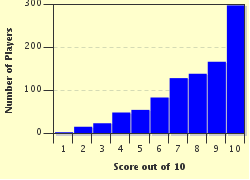Quiz Answer Key and Fun Facts
1. Our visit to Togo starts at the seaside city of Aného. On what body of water is this lovely beach located?
2. One of the many ethnic groups to be found in Togo is the Yoruba people, renowned as sculptors. They are also famed for wood carvings such as this ibeji, a figurine which plays a significant role in their religion. Can you determine what the word ibeji might mean in English?
3. This Togolese village is surrounded by crop fields. The crop shown growing here is one of the staple food crops for most of western Africa. Which of these is a name for this crop?
4. This picture shows a woman selling fresh produce at a street market in the Kara administrative division, one of the five main administrative divisions of Togo. What name is used for these divisions?
5. Our next stop is the central city of Sokodé, second-largest city in Togo. Many of the festivals here feature imitations of the warriors after whom the local football club is named. What are these traditional warriors called?
6. Continuing on to the northwest part of Togo, we come to a village of the Taberma people. They have unusual houses called 'tata somba', or 'somba house'. The ground floor is not used for living quarters, but serves which of these zoological purposes?
7. This picture was taken during the Evala Festival in the Kara Valley, where the Kabye people live. What activity is involved in evala, the second of three stages in the local initiation rite for young men?
8. Travelling south again, we return to the area of Togo in which the Ewe people predominate. They are known for producing a type of woven strips of brightly-coloured fabric using traditional patterns. What is the name for this West African textile?
9. Arriving back in Lomé, we can visit the fetish market. Featuring prominently in Togolese animist practices, what is a fetish?
10. Our last night in Togo will be spent visiting Kadam-kadam in a suburb of Lomé. What is Kadam-kadam?
Source: Author
looney_tunes
This quiz was reviewed by FunTrivia editor
stedman before going online.
Any errors found in FunTrivia content are routinely corrected through our feedback system.

